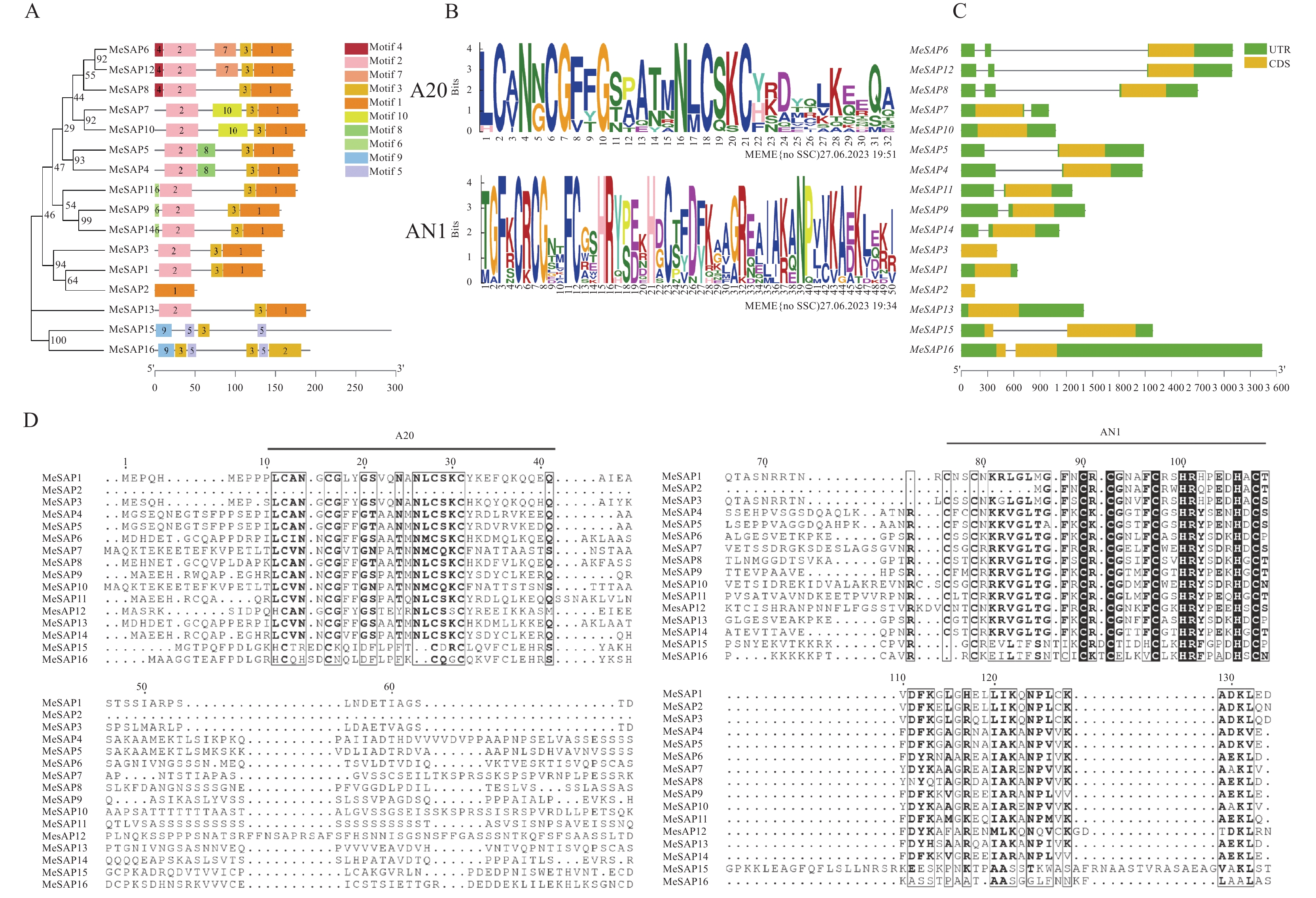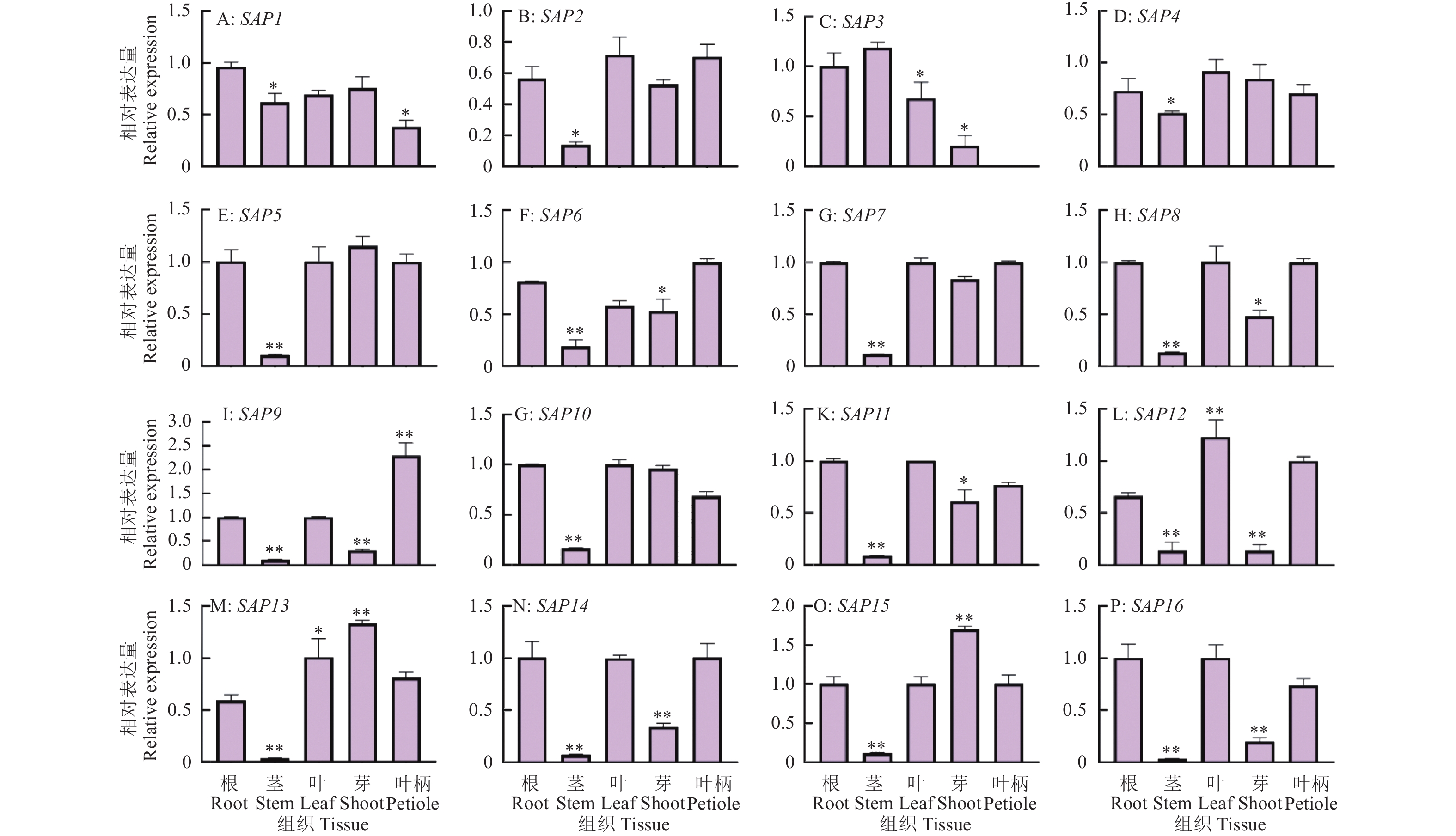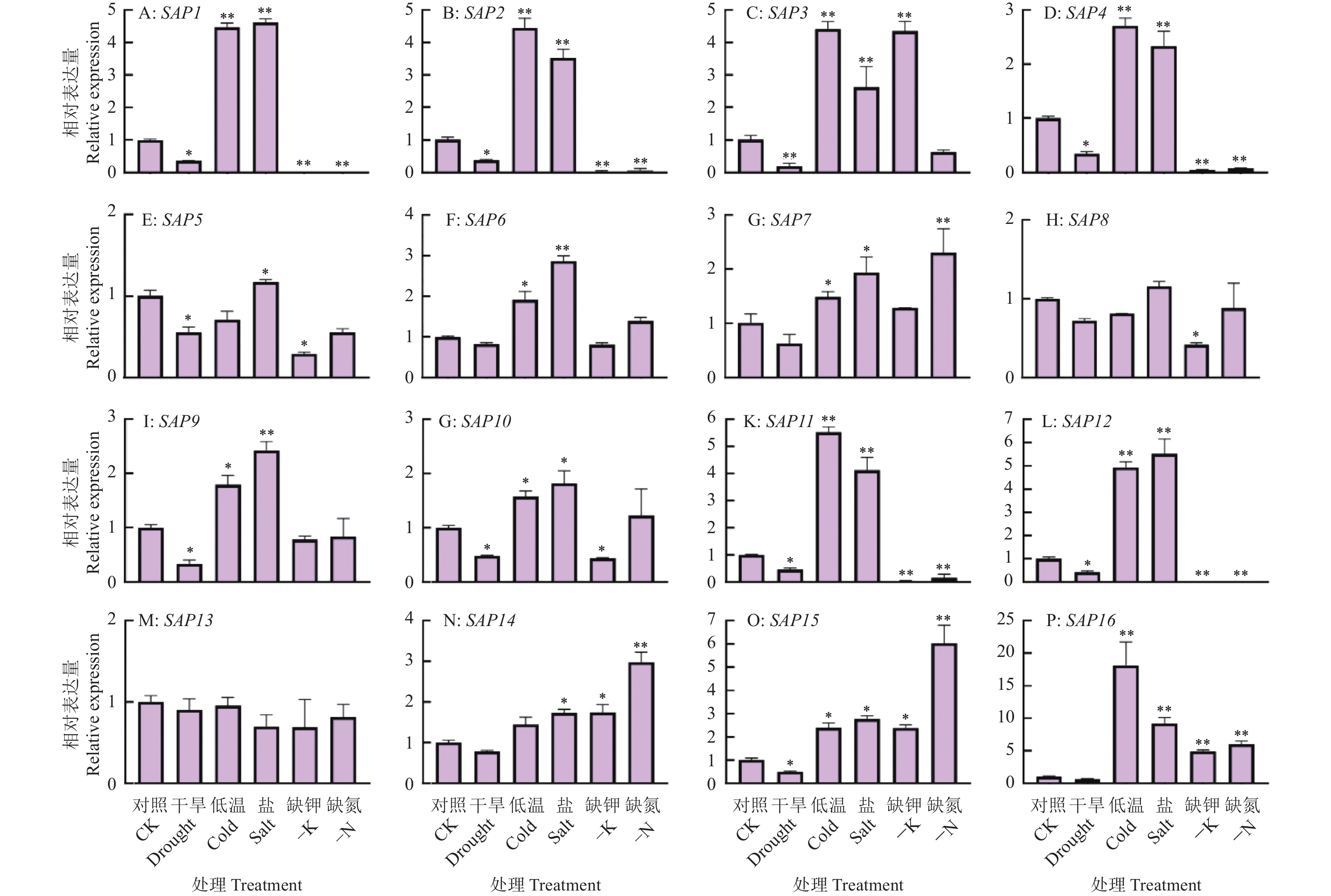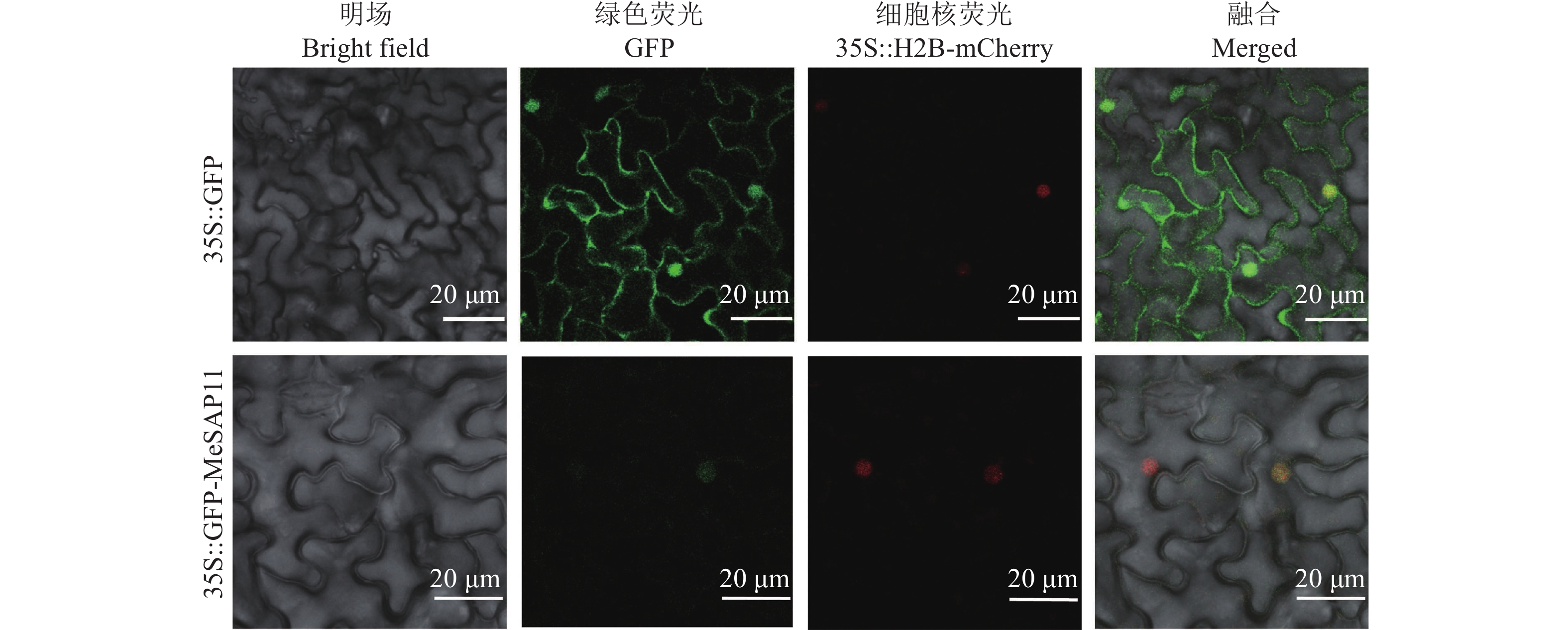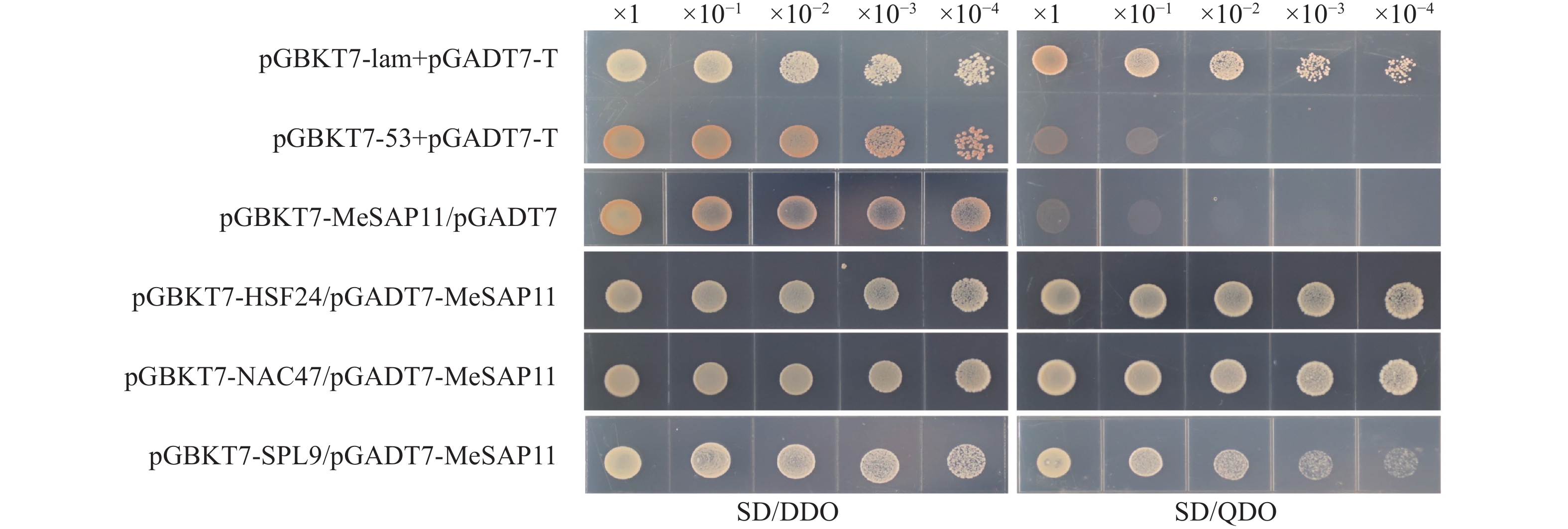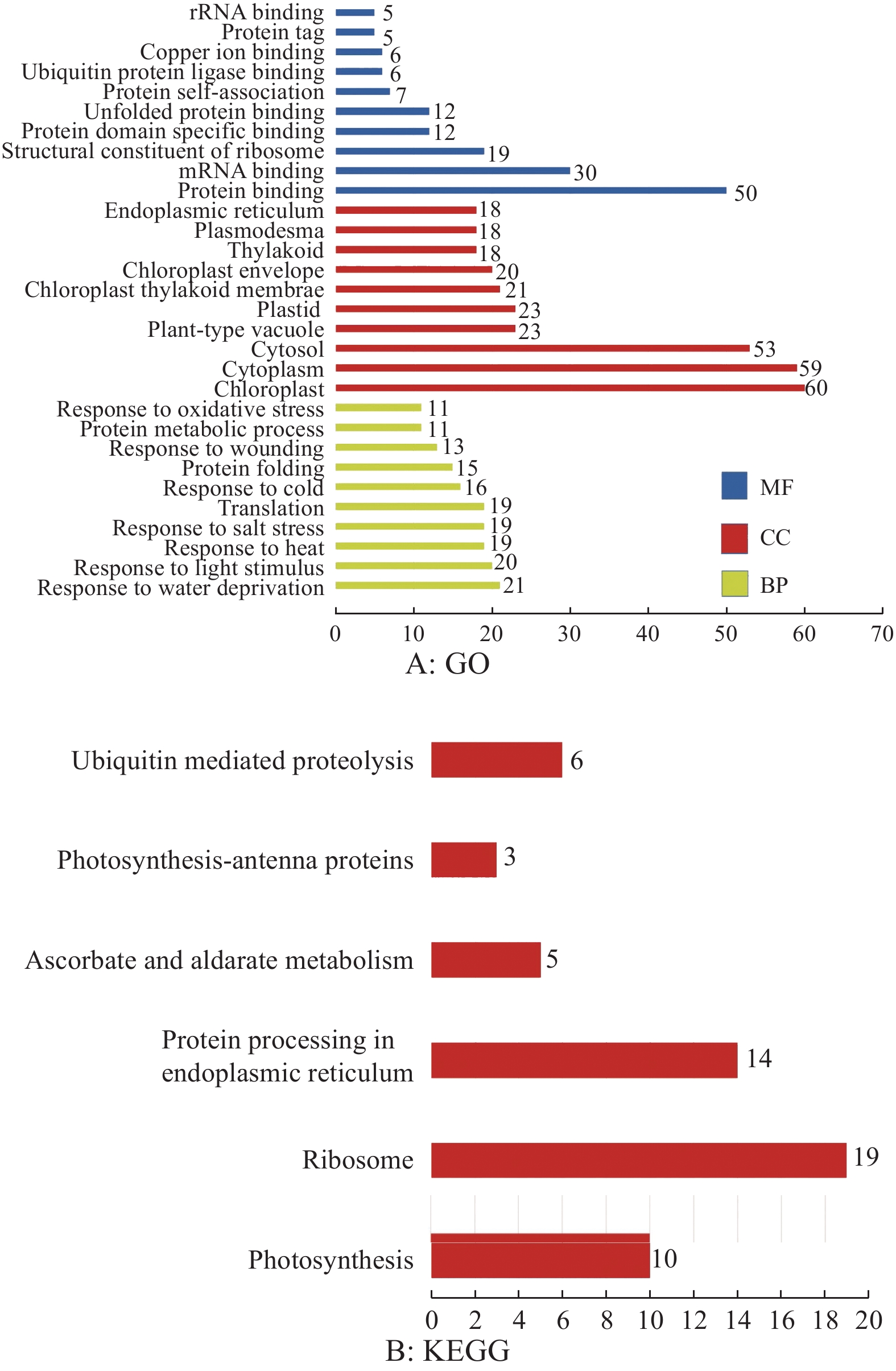Functional analysis of SAP11 gene in cassava
-
摘要:目的
木薯Manihot esculenta Crantz是全球热带地区重要的粮食作物和经济作物,在生长发育过程中极易遭受低温、干旱、盐碱等非生物胁迫而导致减产。胁迫相关蛋白(Stress-associated protein,SAP)是一类新型的A20/AN1锌指蛋白,在模式作物应对多种非生物胁迫过程中发挥重要作用。目前,SAP基因在木薯应对非生物胁迫中的生物学功能尚不明确。本研究旨在分析木薯SAP家族成员的蛋白结构特征和表达模式,以及MeSAP11的互作蛋白,为进一步解析该家族基因在木薯抗逆中的功能提供理论支撑。
方法利用生物信息学技术对木薯SAP家族成员的进化关系、蛋白基序信息以及时空表达模式开展系统分析。同时,通过qRT-PCR研究各基因成员在不同组织中的特异表达以及对不同非生物胁迫的响应。进一步运用酵母双杂交结合高通量测序技术获得与MeSAP11相互作用的蛋白及对应生物学通路。
结果木薯SAP基因家族共6个大类16个成员,该家族成员在木薯根部和叶片中表达量较高,部分家族成员的表达在低温和盐胁迫中显著上调,在干旱、钾饥饿和氮饥饿显著下调。MeSAP11的表达受不同胁迫条件的显著调控,亚细胞定位结果表明MeSAP11蛋白主要定位在细胞核。利用酵母双杂交筛库技术筛选到256个与MeSAP11互作的蛋白,KEGG分析表明这些互作基因主要参与蛋白泛素化降解、内质网蛋白质加工通路等途径,暗示MeSAP11可能通过上述通路发挥功能。
结论木薯SAP 家族大部分成员显著响应低温、干旱、高盐以及缺氮、缺钾胁迫,研究结果为进一步研究MeSAP11在木薯响应非生物胁迫过程中的功能并解析其调控网络奠定了基础。下一步将把MeSAP11基因列为调控非生物逆境变化的候选基因开展深入研究。
Abstract:ObjectiveCassava is an important food and economic crop in tropical regions worldwide, and it is highly susceptible to yield reduction due to non-biological stresses such as low temperature, drought, and salinity during its growth and development. Stress-associated proteins (SAPs) are a novel class of A20/AN1 zinc finger proteins that play important roles in the response of model crops to various non-biological stresses. The biological functions of SAPs in cassava’s response to non-biological stresses are not yet clear. This study aims to analyze the protein structure characteristics and expression patterns of the cassava SAPs, as well as the interacting proteins of MeSAP11, and provide theoretical support for further understanding the function of cassava SAPs in response to abiotic stresses.
MethodBioinformatics techniques were used to systematically analyze the evolutionary relationships, protein motif information, and spatiotemporal expression patterns of the cassava SAPs. Additionally, qRT-PCR was used to study the specific expression of each gene member in different tissues and their response to abiotic stresses. Furthermore, yeast two-hybrid combined with high-throughput sequencing technology was used to identify the proteins interacting with MeSAP11 and their corresponding biological pathways.
ResultThe cassava SAP gene family consisted of six major classes and 16 members. The expression levels of these family members were higher in cassava roots and leaves. The expressions of several family members were significantly up-regulated by low temperature and salt stress, and significantly down-regulated by drought, potassium starvation and nitrogen starvation. The expression of MeSAP11 was significantly regulated under different stress conditions, and subcellular localization results indicated that the MeSAP11 protein was mainly located in the nucleus. Using yeast two-hybrid screening, 256 proteins were identified to interact with MeSAP11, and KEGG analysis indicated that these interacting genes are mainly involved in protein ubiquitination degradation and endoplasmic reticulum protein processing pathways, suggesting that MeSAP11 may function through these pathways.
ConclusionThe majority of the cassava SAPs are significantly regulated by low temperature, drought, high salinity, nitrogen deficiency, and potassium deficiency stresses. These results lay a theoretical fundation for the function exploration of MeSAP11 in cassava responding to abiotic stress, and point out a direction for further study to unravel its regulatory network. MeSAP11 is identified as a candidate gene for further in-depth research on regulating non-biological stress changes.
-
Keywords:
- Cassava /
- Abiotic stress /
- MeSAP gene /
- Protein-protein interaction screening
-
-
表 1 木薯MeSAP家族蛋白的理化性质
Table 1 Physical and chemical properties of MeSAP family protein in cassava
名称
Name氨基酸数量
Number of
amino acid相对分子质量
Relative molecular
weight理论等电点
Theoretical
PI不稳定系数
Instability
index蛋白疏水性
Aliphatic
index脂溶性系数
Coefficient of fat
solubilityMeSAP1 136 15 101.02 8.02 46.82 57.50 −0.744 MeSAP2 51 6 004.96 5.40 49.63 65.10 −0.698 MeSAP3 135 14 950.05 8.93 52.51 61.48 −0.583 MeSAP4 179 18 922.35 7.99 34.34 58.94 −0.380 MeSAP5 173 18 308.73 8.68 25.06 58.21 −0.387 MeSAP6 171 18 467.02 8.44 30.59 61.11 −0.480 MeSAP7 179 19 204.52 9.01 44.22 52.91 −0.618 MeSAP8 170 17 892.20 8.48 32.07 60.88 −0.284 MeSAP9 156 17 325.93 8.90 49.73 58.21 −0.440 MeSAP10 188 20 393.91 8.90 40.45 55.59 −0.545 MeSAP11 176 18 929.37 9.13 54.33 60.40 −0.431 MeSAP12 192 21 446.91 9.37 44.90 38.70 −0.782 MeSAP13 173 18 534.17 8.44 26.36 66.53 −0.349 MeSAP14 160 17 700.14 8.75 43.69 57.31 −0.589 MeSAP15 293 32 420.86 8.65 46.82 62.56 −0.597 MeSAP16 192 21 220.33 8.98 37.91 57.97 −0.588 表 2 MeSAP11酵母在cDNA文库的筛选结果
Table 2 Screening of MeSAP11 yeast in cDNA library
基因编号
Gene number注释
AnnotationManes.13G013400.1 小热休克蛋白HSP20 Manes.11G058600.1 聚泛素3 Polyubiquitin 3 Manes.17G035300.1 泛素样蛋白 Ubiquitin-like proteins Manes.16G032100.1 DNAJ同源家族C成员 DNAJ member C Manes.04G165900.1 GTPase激活蛋白 AGD11 Manes.01G042200.1/
Manes.13G124500.1热休克蛋白热应激转录因子
Heat shock protein HSF24Manes.07G019300.1 聚泛素4 Polyubiquitin 4 Manes.09G144100.1 转录因子 NAC47 Manes.09G032800.1 转录因子 SPL9 Manes.14G148600.1 I 类热休克蛋白
Class I heat shock proteinManes.09G042800.1 未知蛋白 Uncharacterized protein Manes.12G078200.1 WD重复蛋白 WD protein Manes.15G054800.1 转换因子 Translation factor Manes.05G204500.1 一种配子表达的跨膜蛋白HAP8 Manes.13G087500.1 蛋白激酶家族蛋白
Protein kinase family proteinsManes.09G036800.1 泛素样蛋白 Ubiquitin-like proteins -
[1] 曹升, 陈江枫, 黄富宇, 等. 广西木薯产业现状分析及其发展建议[J]. 南方农业学报, 2021, 52(6): 1468-1476. doi: 10.3969/j.issn.2095-1191.2021.06.005 [2] WANG W Q, FENG B X, XIAO J F, et al. Cassava genome from a wild ancestor to cultivated varieties[J]. Nature Communications, 2014, 5: 5110. doi: 10.1038/ncomms6110
[3] COBB J N, DECLERCK G, GREENBERG A, et al. Next-generation phenotyping: Requirements and strategies for enhancing our understanding of genotype-phenotype relationships and its relevance to crop improvement[J]. Theoretical and Applied Genetics, 2013, 126(4): 867-887. doi: 10.1007/s00122-013-2066-0
[4] 李智博, 董世满, 李淑霞, 等. 木薯SR45亚家族基因鉴定及表达[J]. 华南农业大学学报, 2022, 43(5): 20-28. doi: 10.7671/j.issn.1001-411X.202111032 [5] GONG Z, XIONG L, SHI H, et al. Plant abiotic stress response and nutrient use efficiency[J]. Science China-Life Sciences, 2020, 63(5): 635-674. doi: 10.1007/s11427-020-1683-x
[6] LANDI S, HAUSMAN J F, GUERRIERO G, et al. Poaceae vs. abiotic stress: Focus on drought and salt stress, recent insights and perspectives[J]. Frontiers in Plant Science, 2017, 8: 1214. doi: 10.3389/fpls.2017.01214
[7] 朱健康, 倪建平. 植物非生物胁迫信号转导及应答[J]. 中国稻米, 2016, 22(6): 52-60. doi: 10.3969/j.issn.1006-8082.2016.06.012 [8] MUKHOPADHYAY A, VIJ S, TYAJI A. Overexpression of a zinc-finger protein gene from rice confers tolerance to cold, dehydration, and salt stress in transgenic tobacco[J]. Proceedings of the National Academy of Sciences of the United States of America, 2004, 101(16): 6309-6314.
[9] 崔江慧, 杨溥原, 常金华. 高粱GRF基因家族鉴定及在非生物胁迫下的表达分析[J]. 中国农业科技导报, 2021, 23(4): 37-46. [10] KOTHARI K S, DANSANA P K, GIRI J, et al. Rice stress associated protein 1 (OsSAP1) interacts with aminotransferase (OsAMTR1) and pathogenesis-related 1a protein (OsSCP) and regulates abiotic stress responses[J]. Frontiers in Plant Science, 2016, 7: 1057.
[11] KANG M, ABDELMAGEED H, LEE S, et al. AtMBP-1, an alternative translation product of LOS2, affects abscisic acid responses and is modulated by the E3 ubiquitin ligase AtSAP5[J]. The Plant Journal, 2013, 76(3): 481-93. doi: 10.1111/tpj.12312
[12] WANG W X, VINOCUR B, ALTMAN A. Plant responses to drought, salinity and extreme temperatures: Towards genetic engineering for stress tolerance[J]. Planta Medica, 2003, 218(1): 1-14.
[13] DANSANA P K, KOTHARI K S, VIJ S, et al. OsiSAP1 overexpression improves water-deficit stress tolerance in transgenic rice by affecting expression of endogenous stress-related genes[J]. Plant Cell Reports, 2014, 33(9): 1425-1440. doi: 10.1007/s00299-014-1626-3
[14] HUANG J, WANG M M, JIANG Y, et al. Expression analysis of rice A20/AN1-type zinc finger genes and characterization of ZFP177 that contributes to temperature stress tolerance[J]. Genes, 2008, 420(2): 135-144.
[15] VIJ S, TYAGI A. Genome-wide analysis of the stress associated protein (SAP) gene family containing A20/AN1 zinc-finger(s) in rice and their phylogenetic relationship with Arabidopsis[J]. Molecular Genetics And Genomics, 2006, 276(6): 565-575. doi: 10.1007/s00438-006-0165-1
[16] JIA H X, LI J B, ZHANG J, et al. Genome-wide survey and expression analysis of the stress-associated protein gene family in desert poplar, Populus euphratica[J]. Tree Genetics & Genomes, 2016, 12(4): 78.
[17] BILLAH S A, KHAN N Z, ALI W, et al. Genome-wide in silico identification and characterization of the stress associated protein (SAP) gene family encoding A20/AN1 zinc-finger proteins in potato (Solanum tuberosum L.)[J]. PLoS One, 2022, 17(8): e0273416. doi: 10.1371/journal.pone.0273416
[18] HE X, XIE S, XIE P, et al. Genome-wide identification of stress-associated proteins (SAP) with A20/AN1 zinc finger domains associated with abiotic stresses responses in Brassica napus[J]. Environmental and Experimental Botany, 2019, 165: 108-119. doi: 10.1016/j.envexpbot.2019.05.007
[19] KANNEGANTI V, GUPTA A K. Overexpression of OsiSAP8, a member of stress associated protein (SAP) gene family of rice confers tolerance to salt, drought and cold stress in transgenic tobacco and rice[J]. Plant Molecular Biology Reporter, 2008, 66(5): 445-462. doi: 10.1007/s11103-007-9284-2
[20] HOZAIN M, ABDELMAGEED H, LEE J, et al. Expression of AtSAP5 in cotton up-regulates putative stress-responsive genes and improves the tolerance to rapidly developing water deficit and moderate heat stress[J]. Journal of Plant Physiology, 2012, 169(13): 1261-1270. doi: 10.1016/j.jplph.2012.04.007
[21] BEN S R, MEYNARD D, BEN R W, et al. The promoter of the AlSAP gene from the halophyte grass Aeluropus littoralis directs a stress-inducible expression pattern in transgenic rice plants[J]. Plant Cell Reports, 2015, 34(10): 1791-1806. doi: 10.1007/s00299-015-1825-6
[22] LI J, SUN P, XIA Y, et al. A stress-associated protein, PtSAP13, from Populus trichocarpa provides tolerance to salt stress[J]. International Journal of Molecular Sciences, 2019, 20(22): 5782. doi: 10.3390/ijms20225782
[23] FUENTES-BEALS C, VALDÉS-JIMÉNEZ A, RIADI G. Hidden Markov Modeling with HMMTeacher[J]. PLoS Computational Biology, 2022, 18(2): e1009703. doi: 10.1371/journal.pcbi.1009703
[24] GOODSTEIN D M, SHU S, HOWSON R, et al. Phytozome: A comparative platform for green plant genomics[J]. Nucleic Acids Research, 2012, 40(D1): D1178-D1186. doi: 10.1093/nar/gkr944
[25] CHEN C J, CHEN H, ZHANG Y, et al. TBtools: An integrative tookit developed for interactive analyses of big biological data[J]. Molecular Plant Pathology, 2020, 13(8): 1194-1202.
[26] KUMAR S, STECHER G, TAMURA K. MEGA7: Molecular evolutionary genetics analysis version 7.0 for bigger datasets[J]. Molecular Biology and Evolution, 2016, 33(7): 1870-1874. doi: 10.1093/molbev/msw054
[27] SHARMA G, GIRI J, TYAGI A K. Rice OsiSAP7 negatively regulates ABA stress signalling and imparts sensitivity to water-deficit stress in Arabidopsis[J]. Plant Science, 2015, 237: 80-92. doi: 10.1016/j.plantsci.2015.05.011
[28] DIXIT A R, DHANKHER O P. A novel stress-associated protein ‘AtSAP10’ from Arabidopsis thaliana confers tolerance to nickel, manganese, zinc, and high temperature stress[J]. PLoS One, 2011, 6(6): e20921. doi: 10.1371/journal.pone.0020921
[29] 张子奇, 李可, 陈银华, 等. 木薯MeSAP13基因的克隆及其抗细菌性枯萎病功能鉴定[J]. 热带作物学报, 2022, 43(10): 1981-1988. [30] ZHAO P, WANG D D, WANG R Q, et al. Genome-wide analysis of the potato Hsp20 gene family: Identification, genomic organization and expression profiles in response to heat stress[J]. BMC Genomics, 2018, 19(1): 61. doi: 10.1186/s12864-018-4443-1
[31] LI S X, CHENG Z H, LI Z B, et al. MeSPL9 attenuates drought resistance by regulating JA signaling and protectant metabolite contents in cassava[J]. Theoretical and Applied Genetics, 2022, 135(3): 817-832. doi: 10.1007/s00122-021-04000-z
[32] LIU G Z, LI X L, JIN S X, et al. Overexpression of rice NAC gene SNAC1 improves drought and salt tolerance by enhancing root development and reducing transpiration rate in transgenic cotton[J]. PLoS One, 2014, 9(1): e86895. doi: 10.1371/journal.pone.0086895
[33] KIM G D, CHO Y H, YOO S D. Regulatory functions of evolutionarily conserved AN1/A20-like Zinc finger family proteins in Arabidopsis stress responses under high temperature[J]. Biochemical and Biophysical Research Communications, 2015, 457(2): 213-220. doi: 10.1016/j.bbrc.2014.12.090



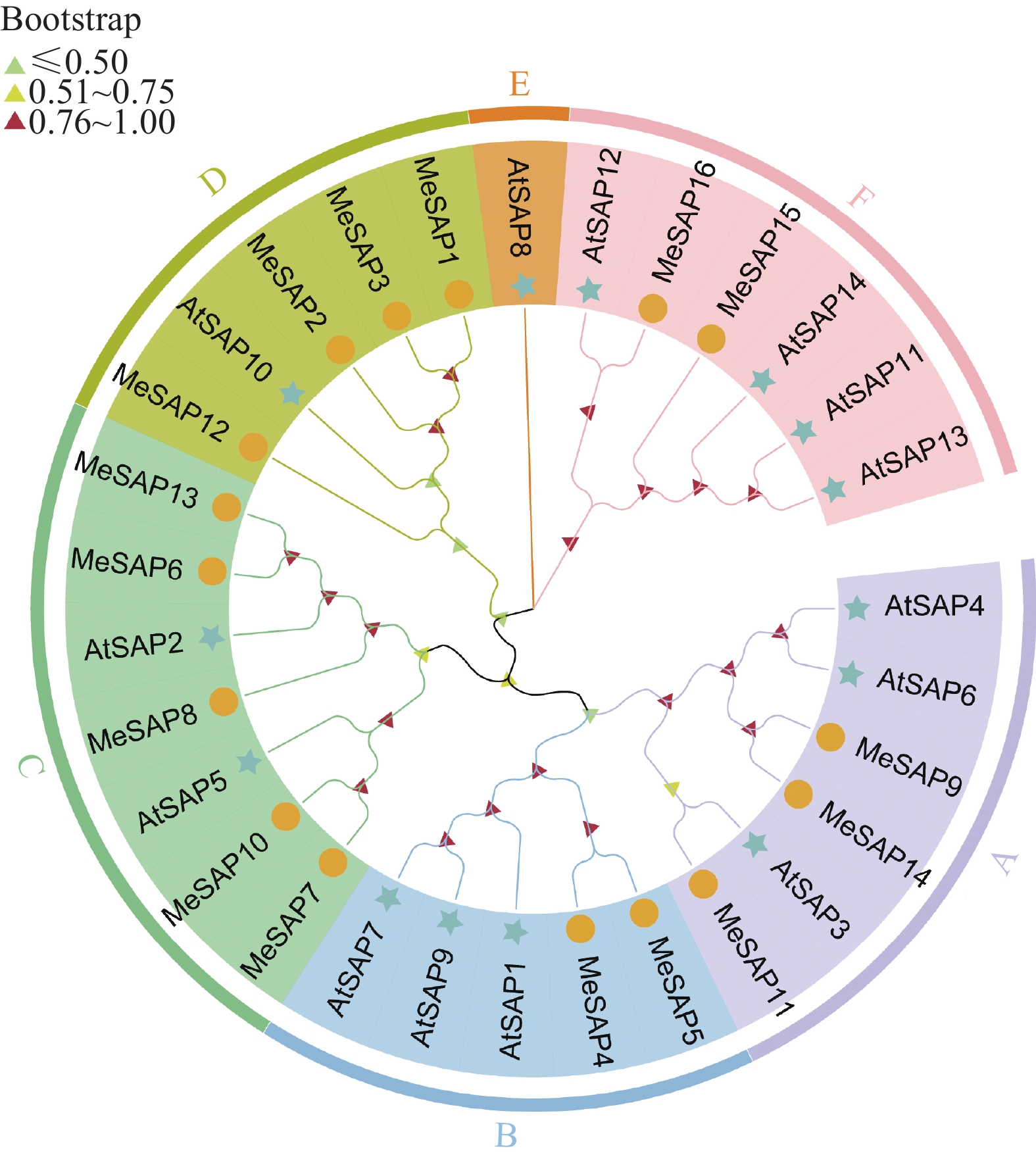
 下载:
下载:
